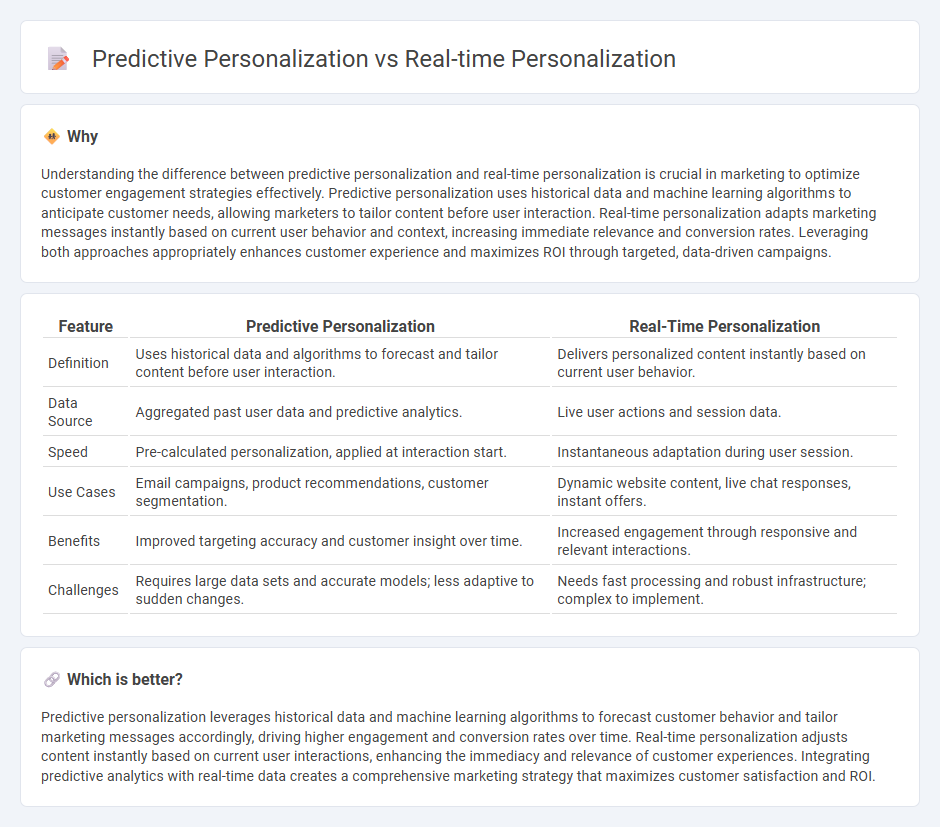
Predictive personalization uses historical data and machine learning algorithms to anticipate customer needs, enabling tailored marketing strategies before user interaction. Real-time personalization adapts content dynamically based on immediate user behavior, delivering customized experiences in the moment. Explore the unique benefits and applications of both approaches to optimize your marketing efforts.
Why it is important
Understanding the difference between predictive personalization and real-time personalization is crucial in marketing to optimize customer engagement strategies effectively. Predictive personalization uses historical data and machine learning algorithms to anticipate customer needs, allowing marketers to tailor content before user interaction. Real-time personalization adapts marketing messages instantly based on current user behavior and context, increasing immediate relevance and conversion rates. Leveraging both approaches appropriately enhances customer experience and maximizes ROI through targeted, data-driven campaigns.
Comparison Table
| Feature | Predictive Personalization | Real-Time Personalization |
|---|---|---|
| Definition | Uses historical data and algorithms to forecast and tailor content before user interaction. | Delivers personalized content instantly based on current user behavior. |
| Data Source | Aggregated past user data and predictive analytics. | Live user actions and session data. |
| Speed | Pre-calculated personalization, applied at interaction start. | Instantaneous adaptation during user session. |
| Use Cases | Email campaigns, product recommendations, customer segmentation. | Dynamic website content, live chat responses, instant offers. |
| Benefits | Improved targeting accuracy and customer insight over time. | Increased engagement through responsive and relevant interactions. |
| Challenges | Requires large data sets and accurate models; less adaptive to sudden changes. | Needs fast processing and robust infrastructure; complex to implement. |
Which is better?
Predictive personalization leverages historical data and machine learning algorithms to forecast customer behavior and tailor marketing messages accordingly, driving higher engagement and conversion rates over time. Real-time personalization adjusts content instantly based on current user interactions, enhancing the immediacy and relevance of customer experiences. Integrating predictive analytics with real-time data creates a comprehensive marketing strategy that maximizes customer satisfaction and ROI.
Connection
Predictive personalization leverages data analytics and machine learning algorithms to anticipate customer preferences and behaviors, enabling brands to tailor marketing efforts before interactions occur. Real-time personalization uses this predictive insight to dynamically adjust content, offers, and user experiences during the customer's active engagement. Together, these strategies enhance customer satisfaction and conversion rates by delivering highly relevant marketing messages at precisely the right moment.
Key Terms
User Behavior Data
Real-time personalization leverages immediate user behavior data such as clicks, scrolls, and time spent on pages to tailor content or offers dynamically during the user session. Predictive personalization uses historical user behavior data combined with machine learning algorithms to forecast future preferences and customize experiences proactively. Explore how these approaches harness user behavior data to optimize engagement and conversion rates.
Machine Learning Algorithms
Machine learning algorithms power both real-time and predictive personalization by analyzing user behavior to tailor experiences dynamically or forecast future preferences. Real-time personalization leverages algorithms such as clustering and classification for immediate content adaptation, while predictive personalization uses time series analysis and neural networks to anticipate user needs. Explore the differences in these machine learning techniques to enhance your personalization strategy effectively.
Dynamic Content
Real-time personalization delivers dynamic content by instantly adapting website elements based on the visitor's current behavior, such as live browsing patterns or recent interactions, ensuring immediate relevance. Predictive personalization uses AI and historical data to forecast user preferences and tailor dynamic content proactively, anticipating needs before they arise. Explore how leveraging real-time and predictive approaches can optimize dynamic content strategies for enhanced user engagement.
Source and External Links
Real-Time Personalization Explained - Real-time personalization uses live customer data to instantly adapt messages, content, and experiences as customers interact, ensuring timely and relevant engagements across all channels.
Real-Time Personalization: What It Is & How It Works - It delivers customized content based on immediate user actions--like cart abandonment or browsing--by instantly updating customer profiles and dynamically generating offers, recommendations, and messages tailored to each individual's current context.
What Is Real-Time Personalization? - Marketing - This process unifies data from all customer touchpoints, leverages AI for rapid analysis, and instantly serves personalized content, offers, or experiences to maximize engagement, sales, and retention.
 dowidth.com
dowidth.com